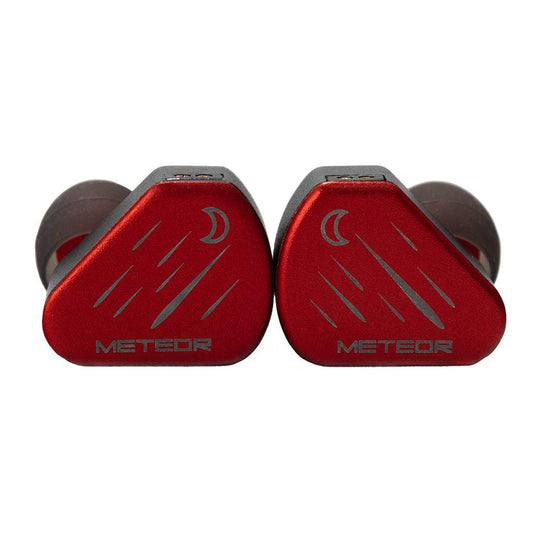Symphonium Giant: The Experiment
Described as an experiment by its creators, the Symphonium Giant is a departure from the brands other offerings. Will its unique tuning succeed? Fc-Construct takes a look.

Introduction
Where do you go after creating something that everyone likes? That’s one of the great conundrums of the audio hobby. With the mantra that tuning is the most important thing to sound quality, and the emphasis on target curves that satisfy the majority of the population, does it make business sense to make something that appeals to less people? It’s why we see the same tunings over and over again, with the (perhaps sometimes unfair) critique that IEMs are in a race to the bottom.
Symphonium is a brand facing this dilemma. They’ve consistently put out great IEMs, in part due to modeling after widely accepted tonal profiles. But with half a dozen models in their line-up, a departure was inevitable. Enter the Symphonium Giant. Conceived by its creators as “an experiment to see how warm they could go,” the Giant comes in at $699 featuring a hybrid dynamic driver + balanced armature setup. Let's see just how far they went.
What we like
- Big, fun bass shelf
- Relaxed upper mids tuning
- Comfortable shell design
What we don’t like
- Upper treble peak can be piercing
- Particularly sensitive to recording quality

Fit and Comfort
Unlike many IEMs these days, the Giant thankfully has a very reasonable shell size. It’s not the smallest from Symphonium (that honour goes to the Meteor), but it is pleasantly unobtrusive. The shell design is a striking ice blue colourway featuring a carbon composite faceplate. It feels robust and made of solid aluminum. The comfort is quite good, and this is aided with their CORE+ venting system to prevent pressure build-up in-ear. Comfortable IEMs are sadly no longer a given, so the Giant wins some points from me here.
In terms of accessories, you get the standard package:
- Seven pairs of tips, in two different styles. S/MS/M/L Symphonium House and S/M/L of their Premium tips.
- A sleek braided 2-pin black cable. It comes with interchangeable 3.5 and 4.4 mm terminations which is always nice to see. No complaints whatsoever with the cable.
- Black carrying case. This is a flip-top style case and does look pretty stylish.
One thing to note is that the nozzle size is quite large at 6.6 mm. Surprisingly, this wasn't something I noticed until I took measurements of its diameter.

Sound - Objective
Before we get into the subjective part of this review, let’s take a look at the frequency response graph of the Symphonium Giant. If you’re new to reading graphs, here is the high-level explanation - if the line is within the grey region, it means it’s likely to sound balanced (or neutral, for lack of a better word). Put another way, frequencies that are outside the preference bounds are likely to sound colored.
Right off the bat, we can see that the Giant is a coloured IEM. That is a very large bass shelf that extends well into the lower mids, while the upper mids at 3 kHz has a major dip. This means that you can expect the Giant to be a fairly warm IEM, with some potential bass bloat. That 3 kHz is likely to manifest as a general vocal recession rather than a complete blanket as it’s flanked by some good 1-2 kHz presence and lower treble energy at 5-8 kHz.
Finally, we have a large peak in the upper treble. Keep in mind that even on the more accurate B&K 5128 measurement rig, treble measurements are still to be taken with a grain of salt as it depends greatly on your ear anatomy. That said, with a relatively narrow peak like this, you can expect it to manifest as an occasionally sharp peak rather than making the Giant an overall bright IEM.
Here is the raw graph which is a different visualization of the same dataset.
One final, important point I’d like to note is the preference bounds (depicted in the grey region). As mentioned, if the line is within the bounds, it’s likely to sound balanced. And that means it’s most likely to be preferred by the average person - hence the name, preference bounds. That said, 1) You are not an average person; and 2) There’s no reason why you can’t enjoy multiple types of tunings. It’s a question of probability.

Sound - Subjective
We’ll get into my subjective opinion on the Giant’s sound now. As a reminder, this is effectively my interpretation and experience of what the frequency response at the ear drum sounds like. Obviously, my ear anatomy will be different from the measurement rig. And I’ll be using this IEM over a period of time which means my hearing will partially adapt to its sound signature.
It’s an important clarification because the language used to describe sound oftentimes categorizes sound quality into “tonality” or “technicalities”. While this can be a useful framework of understanding, particularly for an experiential hobby like this, it is important to recognize that they are intertwined with one another at the level of the frequency response. Neither of them exists independently outside of it.
On to the review.
Bass
The bass of the Giant is a double edged sword. It’s firmly in the basshead territory for quantity, and its presence is exaggerated by the Giant’s recessed upper mids. Bass quality has a very rounded characteristic due to the significant lower mids bleed. There’s sufficient transient definition for a little bit of punch, but in general the shape of bass notes comes off as boomy and plodding. It does feel a little slow, but not so slow that it gets congested on fast tracks. Where the Giant works best is in songs where the kick drum provides a straightforward pulsing beat that isn’t crowded by the toms. Solitary bass guitar notes are thick, which can obscure the snappiness of rapid fire bass lines.

Mids
Besides the bass, the first thing you’ll notice with the Giant is the overall warmth it has. It’s saturated with it. If you’re listening to the Giant for the first time, you might even call it bloated. This feeling of bloat does go away after a few tracks and your brain adapts to its tuning, but it never escapes the sense of lower mids saturation.
Of course, midrange is a question of balance. Thankfully, the Giant doesn’t completely bury the upper mids. Look at the raw graph - there’s presence at 1-2 kHz, and while the 3-4 kHz region is dipped, it’s not eradicated. This means that while there isn’t as much clarity for vocals or instruments to cut through a busy mix, it’s not to the level of being muddy.
The two instruments most affected by the Giant’s midrange tuning would be the snare drums and electric guitars. The sharp crack of the snare is diminished, with the body taking the lion’s share of the snare’s timbre. Screaming lead guitars sound more like rhythm electrics playing double duty. And rhythm guitars sound chunky. As for vocals, male vocals become even more bodied while female vocals partially escape due to their naturally higher pitch. While I wasn’t a fan of this colouration initially, like my complaints about the bass, I did get used to it after some time.

Treble
Outside of the upper treble peakiness, the treble of the Giant plays a balancing role. While the graph indicates an elevation in the lower treble around 5-8 kHz, I hear it more as a way to bring back clarity where the Giant needs it. This region allows the hats and cymbals to have some crispness and vocals to have an extra boost of clarity so it isn’t overly veiled. But that is the extent of its contribution. This is not an IEM where the treble is the focus by any means.
The bigger question is whether the large upper treble peak will be a problem for you. It is piercing on occasion, but due to its narrow nature, limits how bright it makes the Giant. How much this affects your music will greatly depend on the recording. In rock or metal tracks filled with crashing hats and cymbals, the Giant can feel uncontrolled.

Presentation
As I spend more time with the Giant, it brings to mind a bit of that concert stadium sound. It’s a dense, filled low-end reminiscent of boomy subwoofers meant to move a crowd, with clarity a little buried and treble somewhat erratic. But despite that suboptimal environment, the Giant finds its fun.
It’s clear that the Giant’s creators paid attention to its perceived technical abilities. While instruments may crowd the same stage, there is sufficient layering and note definition that you can pick them apart as needed. Its soundstage is fair and not too closed in. Imaging is better than the soundstage; it makes good use of the stereo width and even adds center depth so notes feel like they’re coming from deeper within your head than in front of your eyes.

Comparisons
Symphonium x Nightjar Meteor - $600
The closest comparison to the Giant is Symphonium’s own Meteor at $600. They’re tonally different, yet spiritually similar. As you can see in the graph comparing them, both IEMs are warm and bassy affairs with large treble peaks. The Meteor has a semblance of that U-shaped tuning while the Giant doesn’t fall neatly into any classification.
Compared to the Giant, the Meteor aims for a more consistent presentation, overtly warm presentation that’s punctuated with large upper treble peaks. These peaks exaggerate the hats and cymbals in a zingier way than the Giant does, while the overarching warmth veils vocals a little more. The Giant’s bass is the major differentiator here - its dynamic drivers allow it to be less sensitive to having a perfect seal than the Meteor’s balanced armatures, allowing for a deeper, fuller bass response. Otherwise, from a technicalities standpoint, both IEMs are rather similar to each other. I’d say the Giant has a slight edge in imaging.
I say consistent because I find the Meteor responds more predictably across my library than the Giant does. I roughly know how the Meteor will sound in a song while the Giant might surprise me with the size of its bass response or how its treble might play. Between the two, I think I prefer the Giant more. While it doesn’t have that consistency, it reaches greater heights in terms of enjoyment more often than not.
Read Precogvision’s Meteor Review | Read Fc-Construct’s Meteor Impressions
Symphonium Audio x NightJar Meteor In-Ear Headphones
Sennheiser IE 600 - $800
The Giant’s other comparator is the Sennheiser IE 600. This is another IEM famed for its bass response. But that’s where the comparisons end. The IE 600 has significantly different tuning as you can see in the frequency response graph. It’s less bassy and adds plenty of energy into the mids and treble. The IE 600 comes off as a much more vibrant, vivid sounding IEM compared to the warmer Giant. While I could complain about the IE 600’s midrange being a tad too forward, or the treble too bright, I generally prefer the IE 600. And that Sennheiser dynamic driver has an edge in quality - bass is more textured and there’s a better sense of dynamics beyond sheer quantity. However, there are a few caveats to the IE 600 beyond its sound that you should note, which you can read in my review linked below.
All that said, I do view them as distinct IEMs for distinct preferences. The IE 600 should be taken off your list if you want a warm IEM with relaxed vocals. It should also be taken off your list if you’re sensitive to treble. While the Giant has a major peak, it’s nowhere near the in-your-face nature of the IE 600’s treble.
Read Fc-Construct’s IE 600 Review
Sennheiser IE 600 In-Ear Headphones

Should You Buy It?
Maybe. It pains me to say this because I do like playing around with experimental designs that break away from traditional tunings, but the Giant has three hurdles that I can see. The first is that it doesn’t have a clear-cut audience. Unlike say the Letshuoer Mystic 8 that clearly positions itself as a neutral-bright IEM for that customer segment, or the aforementioned Meteor with its downwards tilted signature, the Giant finds itself as a tweener that mixes up a few different sets of preferences. To reiterate, this is an IEM for those who want basshead levels of bass, want a warm, thick midrange that isn’t too relaxed, and wouldn’t be bothered with the occasional treble peak.
The second is that it doesn’t do enough on the perceived technicalities front to give it the boost it needs to definitively overcome its experimental nature. The most I can say is that it’s sufficient. And third is that it’s picky with what tracks it excels in. Pop songs (especially with female leads), bossa nova, and acoustic instrumental recordings are examples of where its strengths are amplified and its shortcomings hidden. Brain burn-in does help for other genres, but only to an extent.
$700 is a lot of money to commit for something that’s just as much of an experiment to its customers as it is to its creators, so why the potential recommendation? Because I still believe that it has its place. The ultimate benchmark for me is whether I enjoyed a product during the review process. I wouldn’t call the Giant consistently enjoyable, but I still found myself nodding along to more songs than I expected when I first heard it. Obviously, don’t get the Giant as your first IEM. Or second. But if you’re at a crossroads in your audio journey and want something out of the ordinary, the Giant is one worth at least trying.


